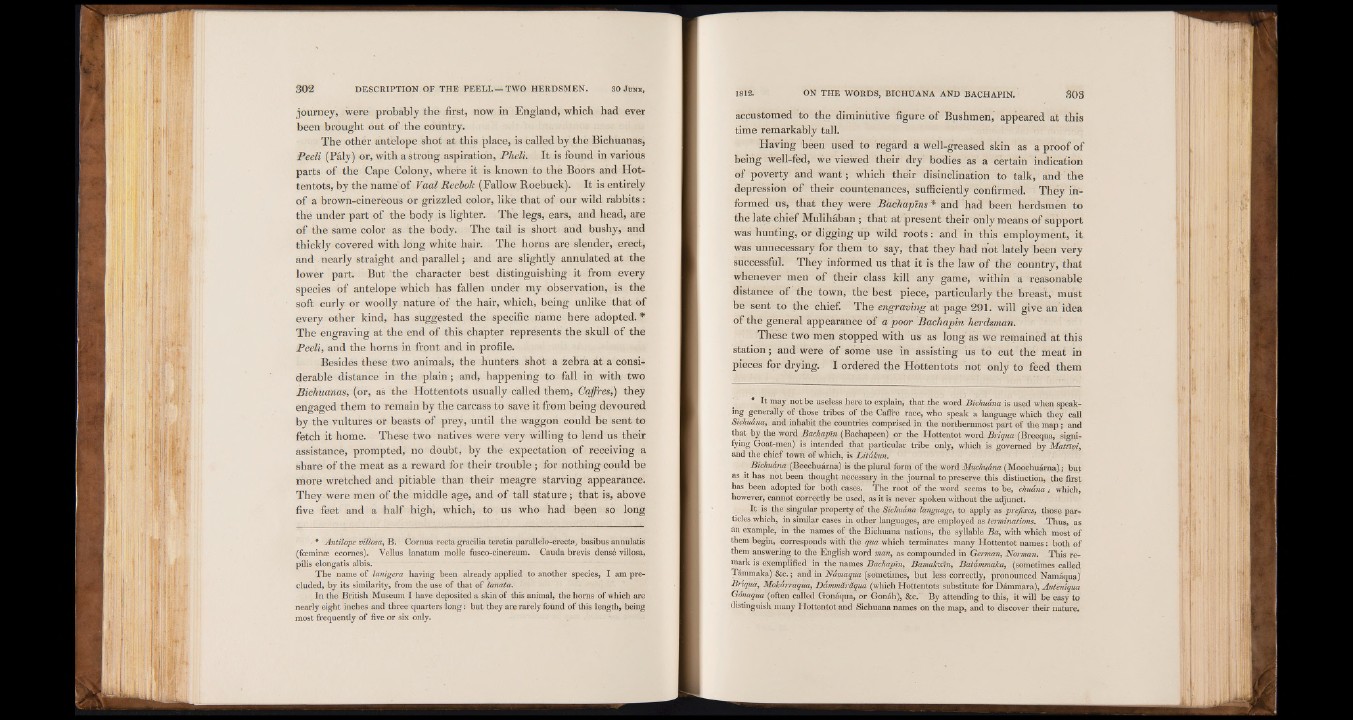
journey, were probably the first, now in England, which had ever
been brought out of the country.
The other antelope shot at this place, is called by the Bichuanas,
Peeli (Paly) or, with a strong aspiration, Pheli. It is found in various
parts of the Cape Colony, where it is known to the Boors and Hottentots,
by the narae'of Vaal Reebok (Fallow Roebuck). It is entirely
of a brown-cinereous or grizzled color, like that of our wild rabbits:
the under part of the body is lighter. The legs, ears, and head, are
of the same color as the body. The tail is short and bushy, and
thickly covered with long white hair. The horns are slender, erect,
and nearly straight and parallel; and are slightly annulated at the
lower part. But the character best distinguishing it from every
species of antelope which has fallen under my observation, is the
soft curly or woolly nature of the hair, which, being unlike that of
every other kind, has suggested the specific name here adopted. *
The engraving at the end of this chapter represents the skull of the
Peeli, and the horns in front and in profile.
Besides these two animals, the hunters shot a zebra at a considerable
distance in the plain; and, happening to fall in with two
Bichuanas, (or, as the Hottentots usually called them, Caffres,) they
engaged them to remain by the carcass to save it from being devoured
by the vultures or beasts of prey, until the waggon could be sent to
fetch it home. These two natives were very willing to lend us their
assistance, prompted, no doubt, by the expectation of receiving a
share of the meat as a reward for their trouble ; for nothing could be
more wretched and pitiable than their meagre starving appearance.
They were men of the middle age, and of tall stature; that is, above
five feet and a half high, which, to us who had been so long
■ * Antilope villosa, B. Gomua recta gracilia teretia parallelo-erecta, basibus annulatis
(foeminae ecomes). Vellus lanatum molle fiisco-cinereum. Cauda brevis dense villosa,
pilis elongatis albis.
The name of lanigcra having been already applied to another species, I am precluded,
by its similarity, from the use of that of lanata.
In the British Museum I have deposited a skin of this animal, the horns of which are
nearly eight inches and three quarters long: but they are rarely found of this length, being
most frequently of five or six only.
accustomed to the diminutive figure of Bushmen, appeared at this
time remarkably tall.
Having been used to regard a well-greased skin as a proof of
being well-fed, we viewed their dry bodies as a certain indication
of poverty and want ; which their disinclination to talk, and the
depression of their countenances, sufficiently confirmed. They informed
us, that they were Bachapms* and had been herdsmen to
the late chief Mulihâban ; that at present their only means of support
was hunting, or digging up wild roots : and in this employment, it
was unnecessary for them to say, that they had not lately been very
successful. They informed us that it is the law of the country, that
whenever men of their class kill any game, within a reasonable
distance of the town, the best piece, particularly the breast, must
be sent to the chief. The engraving at page 291. will give an idea
of the general appearance of a poor Bachapin herdsman.
These two men stopped with us as long as we remained at this
station; and were of some use in assisting us to cut the meat in
pieces for drying. I ordered the Hottentots not only to feed them
It may not be useless here to explain, that .the word Bichuana is used when speaking
generally of those tribes of the Caflre race, who speak a language which they call
SichuAriq, and inhabit the countries comprised in the northernmost part of the map; and
that by the word Bachapin (Bachapeen) or the Hottentot word Briqua (Breequa, signifying
Goat-men) is intended that particular tribe only, which is governed by Matiiyi,
and the chief town of which, is lA tihm .
Bichu&na (Beechuarna) is the plural form of the word Muchy&na (Moochuarna); but
as it has not been thought necessary in the journal to preserve this distinction, the first
has been adopted for both cases. The root of the word seems to be, chu&na s which,
however, cannot correctly be used, as it is never spoken without the adjunct.
It is the singular property of the Sichu&nd language, to apply as prefixes, those particles
which, in similar cases in other languages, are employed as terminations. Thus, as
an example, in the names of the Bichuana nations, the syllable Ba, with which most of
them begin, corresponds with the qua which terminates many Hottentot names: both of
them answering to the English word man, as compounded in German, Norman. This remark
is exemplified in the names Bachapin, Bamahoin, Batdmma/ca, (sometimes called
Tammaka) &c.; and in N&maqua (sometimes, but less correctly, pronounced Namaqua)
Briqua, Mokirraqua, D&mmdr&qua (which Hottentots substitute for Dammara), Auteniqua
Gonaqua (often called Gonaqua, or Gonah), &c. By attending to this, it will be easy to
distinguish, many Hottentot and Sichuana names on the map, and to discover their nature.